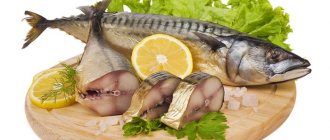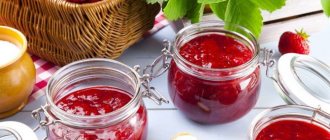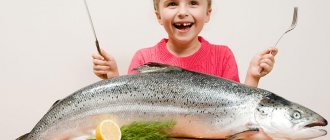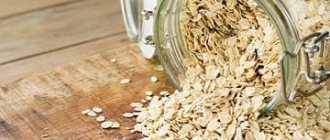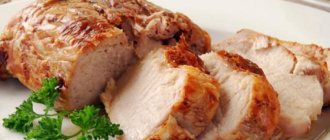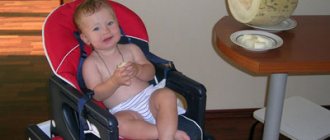The benefits of fish
The child’s menu should consist of the most healthy and safe products. Fish is one of them due to its unique composition. The beneficial effects of fish on a small organism are provided by the following components:
- high content of easily digestible protein necessary for a growing body;
- polyunsaturated fatty acids involved in the structure of muscle cells, affecting proper metabolism;
- vitamin A is involved in the formation of immunity and is important for good vision;
- vitamin D as a preventive measure for the development of rickets;
- B vitamins nourish the nervous system;
- iodine ensures proper functioning of the thyroid gland;
- phosphorus affects brain development, along with calcium, it is necessary for the structure of bones and teeth.
Thanks to its rich composition, fish is healthier than meat and many other products; it is easily digestible and does not put a strain on the pancreas.
What are the benefits of fish for a growing body?
Fish is a unique product, rich in a huge amount of vitamins and nutrients. The main one is fish protein, which is involved in the construction of not only the cells of the child’s body, but also the formation of antibodies to fight various viruses.
Fish contains a large number of useful substances
Fish contains fatty amino acids that the body cannot reproduce itself, but receives only from food. Its digestibility reaches 98% due to the absence of coarse fibers, complex fats and films, and soft fillet is easily digested by enzymes of the gastrointestinal tract. This product is also rich in vitamins and microelements that are necessary for the full development of the child:
- Omega-3 - without this fatty acid, proper metabolism in the body is impossible;
Fish is one of the few sources of omega-3 in the human body.
- vitamin D - helps the absorption of calcium and is involved in the growth of the child’s skeletal system and teeth;
- vitamins A and E - responsible for healthy vision and skin of the baby;
- vitamin B12 - plays a huge role in the development of the baby’s circulatory and nervous systems;
- iodine - it is called the element of the mind, it supports the proper functioning of the thyroid gland, is responsible for brain function;
- Selenium is an important trace element that helps the body develop strong immunity and also protects cells from the negative effects of toxins;
- Calcium plays a major role in the proper development of the child’s skeletal system and teeth. Its deficiency in children can lead to the development of rickets and skeletal deformation;
- iron and copper - regulate the level of hemoglobin in the blood;
- manganese - responsible for the normal growth of the child’s skeleton;
- phosphorus - necessary for tissue regeneration and child growth;
- magnesium - participates in protein synthesis in the body.
When to start introducing the product into the baby's menu
Fish is introduced into the baby's diet after cereals, vegetables, fruits, juices and meat. Early feeding with this product can cause an allergic reaction. Pediatricians recommend giving your child fish puree from 9–10 months, and if the baby suffers from allergies, then from one and a half years .
Fish protein is a strong allergen, so children with allergies try fish much later than healthy children.
Fish, like any other product, is introduced into the child’s diet gradually, starting with half a teaspoon (5–10 grams), increasing by the year to 60–70 grams per day, no more. Parents should know that fish broth should not be given to children under three years of age, so if the product is boiled, it is removed from the water, ground in a blender, and only then offered to the child to try.
When to introduce fish for the first time
Fish is introduced into the diet of a healthy child from 8 months. If by this time the child has not yet eaten meat puree, then you can delay introducing fish until 11 months.
The period of first acquaintance with fish differs between breast-fed and bottle-fed children. Breast milk allows the introduction of healthy fish after 10 months, and artificially introduced fish are recommended to start at 8-9 months.
Sometimes pediatricians advise starting to give fish earlier (after 6 months), but only if there are individual indications:
- suspicion of rickets;
- Iron-deficiency anemia;
- other diseases in children who are bottle-fed.
Fish is an allergenic product, so if a child or his older brothers/sisters have a tendency to allergies, be sure to consult a pediatrician and an allergist before starting fish supplements.
What types of fish can be given to infants and which cannot?
Doctors recommend starting fish feeding with low-fat marine varieties: rivers are more polluted than seas and oceans, so river fish absorbs more toxins. But freshwater inhabitants are not prohibited either; you can try cooking trout, pike or pike perch for your child.
Protein and fat content in fresh fish - table
| Type of fish | Per 100 g | Per serving (200 g) | ||
| squirrels | fats | squirrels | fats | |
| Tuna | 24,4 | 4,6 | 48,8 | 9,2 |
| Sea trout | 21 | 7 | 42 | 14 |
| River trout | 21 | 5 | 42 | 10 |
| Pink salmon | 20,5 | 6,5 | 41 | 13 |
| Salmon | 20 | 13 | 40 | 26 |
| tilapia | 20 | 2 | 40 | 2 |
| Pollock | 19,9 | 0,9 | 39,8 | 1,8 |
| Flounder | 19,7 | 3 | 39,4 | 6 |
| River perch | 18,5 | 0,9 | 37 | 1,8 |
| Zander | 18,4 | 1,1 | 36,8 | 2,2 |
| Pike | 18,4 | 1,1 | 36,8 | 2,2 |
| Sea bass | 18,2 | 3,3 | 36,4 | 6,6 |
| Mackerel | 18 | 14 | 36 | 28 |
| Bream | 17,1 | 4,4 | 34,2 | 8,8 |
| Hake | 16,6 | 2,2 | 33,2 | 4,4 |
| Cod | 16 | 0,6 | 32 | 1,2 |
| Carp | 16 | 5,3 | 32 | 10,6 |
Ready-made fish puree
Fish purees along with vegetables are available for sale from various baby food manufacturers. If you have doubts about the quality of the fish being sold, it is better to buy ready-made fish that have been certified and approved for consumption by infants.
If you decide to cook fish yourself, be sure to check the quality of the product, ask the sellers for certificates and sanitary and epidemiological reports, because the health of your baby depends on this. Pediatricians recommend buying fresh product; frozen fillets contain fewer vitamins and minerals.
Which fish should you introduce first?
Fish in the diet of a child under one year old should be low in fat and have a minimum amount of bones.
A child may categorically refuse a certain type of fish, but eat others with pleasure. The same goes for allergies - they can manifest themselves to a certain variety, so after 1-2 weeks, you can offer your child a different type of fish.
Popular varieties of fish include:
- pollock, navaga - ideal for first feeding, the fat content does not exceed 2-4%, and the baby will certainly like the delicate consistency and lack of a specific smell;
- blue whiting, hake – low-fat sea fish, suitable for feeding children up to one year old;
- cod, flounder are lean varieties, but it is better to introduce them after a year;
- sea bass and crucian carp, herring are fish of medium fat content, fat content is 4-8%, but it is better for a child to consume it after 2 years;
- pink salmon, trout - red varieties, which should be introduced no earlier than 2 years;
- mackerel and herring are fatty varieties with a fat content of more than 8%; it is better to postpone acquaintance with them until at least 3 years.
Sea fish is more important than river fish: it is more dietary; less allergenic; and the content of small bones is minimal.
Pangasius and tilapia are not recommended for children, because they are either grown under artificial conditions, often on growth hormones, or grow at the bottom of reservoirs, so salts of heavy metals and mercury accumulate in them.
How to choose fish for first feeding
Not only the type of fish is important, but also its quality. By choosing a low-quality or stale product, you risk seriously harming your baby. If you want to cook fish yourself, buy it from reliable stores.
When purchasing frozen fillets, pay attention to the layer of ice glaze. If it is broken or uneven, then most likely the fish has been defrosted and frozen several times; such a product is not suitable for feeding a child. And even ice 2-3 mm thick is just what you need.
Buying live fish is preferable and will guarantee freshness if you make the right choice. Fresh fish has a number of characteristics:
- the gills are bright red (or dark red), but in no case black or gray;
- has a fresh smell of the sea or river (depending on the location), but a strong unpleasant fishy smell is a reason to refuse the purchase;
- the eyes are clear and transparent, but if they are cloudy or dry, this means that this is a fish that has been lying on the counter for quite a long time;
- clean, shiny scales indicate the freshness of the product, while dull scales that fall away from the skin are a guarantee that the fish is not fresh;
- if you lightly press on the back, it will quickly restore its shape due to its density and elasticity, while a hole will remain on a stale carcass.
How to prepare fish for first feeding
Most kids will appreciate the taste of fish dishes. But they need to be prepared separately from the common table. It is not necessary to add salt to the fish; it contains a sufficient amount of salt for a small organism.
Since it is recommended to eat fish 2-3 times a week so that your baby doesn’t get tired of it, we offer a selection of popular recipes.
Puree
The healthiest fish is steamed. But it’s quite possible to simply boil or bake it. Next, grind or grind the finished product with a blender until it becomes a liquid puree. For 100 gr. any fish (suitable for the child) add 1 tsp. sunflower oil. You can also add 1 tbsp. l. breast or baked milk. This puree should be stored in the refrigerator in a sealed container for up to 2 days.
Ear
Fish soup or other light fish soup is a suitable dish for children over one year old. Cooking stages.
- Bring 1 liter of water to a boil.
- Peel 2 potatoes, a medium carrot and an onion (optional), cut into small pieces and add to the water.
- After the next boil, put 100 grams of fish fillet into the pan. If you are using fresh fish, boil it separately, then separate the bones and add the resulting fillet to the soup 5 minutes before it is ready. You can cook fresh fish along with vegetables, then the broth will be richer, but you will have to pass the finished product through a sieve to eliminate the presence of small bones.
- Grind the finished fish soup through a sieve and grind with a blender. If your child already knows how to chew, simply mash the ingredients with a fork.
Meatballs
Tender meatballs are recommended for children aged 1 year and older. They can be served with a side dish or separately.
- Prepare minced meat from 200 gr. any white fish.
- Add 30 gr. boiled carrots, passed through a blender.
- Add 1 egg yolk here.
- Add 5 gr. potato starch or 20 gr. white bread soaked in milk.
- Form into small balls.
- Boil the required portion in slightly salted water or steam.
Leftover meatballs can be frozen and cooked immediately before use.
Fish pudding
Fish pudding is a good complementary feeding option. For a child under one year old, it is better to cook it in a double boiler, and for older children (1.5-2 years old) bake it in the oven.
- Boil 100 grams of fish fillet (hake, pollock, navaga, etc.) in salted water, finely chop.
- Boil 1 medium potato and puree.
- Combine fish and potatoes.
- Add to the mixture 1 egg yolk, 2 tbsp. l. milk, 1 tsp. butter.
- Beat 1 egg white until foamy and add to the product mixture.
- Grease the mold with oil and pour out the resulting mass.
- Cook in a water bath or steamer for 30 minutes, or in the oven for 20 minutes.
Cooking fish dishes at home
Fish puree
Fish fillet (without skin) - 60 g, milk and vegetable oil - 1 tsp. spoon.
Boil the fillet in a small amount of water for 15-20 minutes, cool, mince or beat in a blender, after removing all the bones. Add milk, butter, salt, mix well and bring to a boil over low heat.
Steam fish soufflé
Fish fillet - 100 g, milk - 25 g, flour - 3 g, egg - 1/3 pcs., butter - 5 g.
Boil the fish fillet, remove all bones. Pass through a meat grinder with a fine grid, add thick milk sauce (boil the milk with flour for 5-8 minutes), butter, egg yolk, mix, carefully fold the whipped white into the minced meat. Place the mixture in a greased form and cook in a water bath under the lid for 15-20 minutes.
Fish pudding
Fish fillet - 100 g, potatoes - 1/2 pcs., butter - 2 teaspoons, milk - 2 tbsp. spoons, egg - 1/4 pcs.
Boil the peeled potatoes until fully cooked, drain the water, mash with a wooden pestle so that there are no lumps, and dilute with milk. Boil the fish in salted water, remove all the bones. Finely chop the pulp, mix with potatoes, lightly salt, add melted butter (1 teaspoon), yolk and white whipped into a thick foam. Grease the mold with oil, pour the mixture into it, close the lid, place in a water bath and cook for 20-30 minutes.
Fish meatballs
Fish fillet - 60 g, wheat bread - 10 g, yolk - 1/4 pcs., water - 10 ml, vegetable oil - 4 ml.
Remove the bones from fish fillets (for example, cod), pass through a meat grinder with a piece of bread soaked in water, add egg yolk and vegetable oil, mix thoroughly. Form balls from the resulting mass, place in a bowl half filled with water and cook over low heat for 20-30 minutes.
Steamed fish cutlets
Fish fillet - 80 g, milk - 25 ml, white bread - 10 g, egg - 1/4 pc.
Pass the fish fillet through a meat grinder, add white bread soaked in milk, mix, pass through the meat grinder again, add salt, beat the egg and mix until a homogeneous fluffy mass is obtained. Form cutlets from the mixture, steam them, placing them on the grate of a steam pan (special grate inserts for cooking steamed dishes in regular pans can be purchased in the hardware departments of department stores), for 20-30 minutes.
Mashed potatoes in jars and canned fish
All the famous ones, “Agusha”, “FrutoNyanya”, etc.) produce fish fillets in jars, combining it with vegetables. Various types of fish are used: trout, chum salmon, pike perch, etc. Vegetables are usually potatoes, carrots and zucchini.
According to the manufacturers, they do not use GMOs, sugar or preservatives. You can start complementary feeding with canned food. This solution has its pros and cons.
Benefits of jarred fish puree
- convenient and fast - perhaps the main advantage for parents with a constant lack of time;
- the consistency and composition of the puree meets the child’s needs;
- strict quality control guarantees a safe composition;
- There is no risk that your baby will get a fish bone.
Disadvantages of baby food in jars
- age recommendations are not always up to date;
- the presence of a thickener - starch (in general it is harmless, but reduces the value of the main product);
- it is necessary to carefully check the composition to avoid an allergic reaction to some components;
- an open jar cannot be stored for more than a day, whereas to start complementary feeding you need a minimum amount of puree, the rest will have to be thrown away.
How to choose and cook fish for children
For cooking, choose fresh fish grown on a proven farm or in natural conditions. It should be firm and fleshy, with red or pink gills, without any unpleasant odor or spots. The scales should shine, fit tightly to the fish and be solid. Wash and clean the fish thoroughly before cooking. You can soak the fillet for two hours. This will make the product more tender, eliminate harmful substances and foreign odors.
Be careful when preparing fried fish and fish soup for children. Fried foods lose most of their beneficial properties and vitamins. They turn out to be greasy and often contain carcinogens. They are difficult and take a long time to digest and can cause indigestion and stomach upsets, stool problems and other problems.
Therefore, it is better to boil, stew or bake fish for a child. Such dishes retain maximum beneficial properties and vitamins, are easily absorbed and digested. Boiled, stewed or baked fish goes well with cereals and vegetables.
When cooking fish, a large number of extractive substances remain in the water, which irritate the intestines. Therefore, the broth is drained after the fish. If you are making fish soup, cook the fish separately and then add it to the prepared vegetable broth. You can boil the dish for a few minutes.
Many people are interested in how long to cook salmon and trout. Fish should only be placed in boiling water. Cook trout and salmon for 20-30 minutes. If you cut the fillet into pieces, it will cook faster. We offer recipes for dishes with these types of fish that can be prepared for children and the whole family.
Tips for introducing fish into complementary foods
- Start introducing fish into your child’s diet with 0.5 tsp, gradually increasing the portion by year to 100 grams.
- Like any new product, it is better to start introducing fish in the morning so that you can track your baby’s reaction throughout the day.
- For bottle-fed children, the first acquaintance with fish dishes can be made at 8 months, for breastfed babies - 9-10 months.
- Artificial babies should be offered fish dishes before formula, and WHO recommends giving breastfed babies fish after breast milk. By and large, both options have a place to be, because each child is individual.
- Do not mix several types of fish into one dish unless you have previously verified that there is no allergic reaction to each of them.
- Replace meat dishes with fish 2-3 times a week, offering it for lunch or dinner.
- Do not fry fish for your baby (it is already quite fatty), it is better to boil or steam it.
- Frozen fish does not need to be thawed completely, just let it thaw a little in the water.
- It is necessary to lower the fish into boiling water, so it will retain maximum beneficial properties.
- It is better if you offer your baby a freshly prepared dish every time. If this is not possible, you can store the prepared product in the refrigerator for no more than a day.
The child refuses fish
Don't give up on your first try. Offer him a different type of fish or cook it in a different form. If he doesn’t want puree, he’ll probably like soup.
Do not insist under any circumstances, try to postpone the introduction of fish by a week or two or even more. After all, children's taste preferences often change.
If the process is very long, then it is important to understand how to replace fish in the child’s diet. The need for proteins is met by regular consumption of meat and poultry, calcium and phosphorus - eggs and cheese. Important omega-3 and omega-6 acids can be obtained from fish oil, pumpkin oil and olive oil.
When should you wait to introduce complementary foods?
Sometimes it is better to hold off on introducing fish into a child’s diet if there are reasons for this:
- allergic predisposition;
- seasonal allergies;
- temporary intolerance;
- viral infections (any product can be administered only when the child is healthy);
- scheduled vaccination (week before and week after vaccination).
When and how to introduce fish complementary foods into a baby's diet
Fish is usually introduced into complementary foods when the baby is 8-10 months old.
This is done only after the child has already started eating other food of animal origin - meat (after 3-4 weeks). A new product can only be given to a healthy child. In case of the slightest health problems, the introduction of complementary foods should be postponed until complete recovery.
Expert opinion
Sokolova L. S.
Pediatrician of the highest category
Fish is considered one of the most powerful food allergens. If a child has an allergic predisposition, fish complementary foods must be agreed upon with an allergist and pediatrician. Usually such children try fish for the first time after a year.
Acquaintance with new food begins with a minimal portion - no more than half a teaspoon. It is better to introduce complementary foods for the first time during morning feeding: this will allow you to observe the baby throughout the day and draw the right conclusions about how the body reacted to the new product. Do you have a rash or upset bowel movements? Does your baby spit up and become whiny? Refrain from trying to give fish to your child again for a few weeks. A baby's reaction may be caused by a certain type of product. Therefore, next time it is better to change the variety, for example, by preparing a puree not from sea fish, but from river fish.
Canned fish for children
If it is very difficult to find fish, or you doubt the quality of the fish on the shelves, you can offer your baby canned fish from baby food manufacturers. As a rule, fish in its pure form is very rarely found in canned food. Most often, manufacturers fill jars with a mixture of fish and vegetables or porridge, while the share of fish product in canned food usually does not exceed one third of the total volume.
Canned food for children may contain either sea or river fish.
The most common vegetable ingredient in fish and vegetable dishes is:
- cauliflower;
- root vegetables: potatoes and carrots;
- broccoli;
- zucchini;
- pumpkin.
Thanks to vegetables, the biological value of the final product significantly increases , since they enrich the dish with dietary fiber, which is almost completely absent from fish.
To prepare canned fish and cereals, porridges such as pearl barley, rice, buckwheat, corn and semolina are used.
Also, canned fish may contain a little vegetable oil or sometimes butter. The preservative is usually ascorbic acid.
Tokareva Larisa, pediatrician
9, total, today
( 170 votes, average: 4.52 out of 5)
EVERYTHING YOU NEED TO KNOW ABOUT FONTANELLA
Pathological changes in infant stool and methods of treatment
Related Posts
Recommendations for inclusion in the diet
Pollock can be given to a baby after he has become familiar with the main types of vegetables, fruits and cereals, but not earlier than 9-10 months. Some experts recommend delaying the introduction of fish into a baby’s diet until he is one year old if he is predisposed to allergies.
For the first test, pollock puree is suitable, without adding salt and spices. To make the consistency uniform, add a little breast milk (baby formula if the child was fed it) or a drop of sunflower oil to the ground fish.
You need to start with 1/2 tsp. puree. If the baby’s health is normal, the portion is gradually increased and brought to:
- 50 g – at 10 months;
- 60 g – at 12 months;
- 85-90 g – at 1.5 years.
Selection, preparation and cooking
Take high-quality fresh or frozen fish. It is better to choose fillet, as it is easier to prepare and does not require careful preparation. Frozen fillets of high-quality pollock are characterized by a white color without red or pink inclusions.
Before cooking, the whole carcass must be gutted, the head, tail and fins cut off. When cutting, it is important not to damage the gall bladder, otherwise bile will be absorbed into the meat and it will become bitter. Pre-defrost frozen fish in the refrigerator. Do not do this at room temperature or in water, otherwise the fish will lose its rich flavor and some of the nutritional properties.
In any case, thoroughly rinse and clean the pollock, remove all bones, including small ones, even from the fillet. Otherwise, the child risks choking. How to help your baby if he is choking, read here.
For first courses he prepares fish puree. To do this, prepared pollock needs to be cut into pieces and boiled in water or steamed. Place the product in already boiling water. Pour the latter so that it completely covers the fish.
This type of fish is cooked in a saucepan without a lid for about five minutes if it is cut, and ten if it is a whole carcass. However, for children's dishes, it is recommended to cook pollock for 15-20 minutes, even if it is small pieces. After cooking, grind the product with a fork or in a blender, dilute with water, formula or breast milk and cook for another two minutes.
How to cook pollock
When pollock becomes part of the baby’s usual diet, you can give other dishes from this fish. For a one-year-old child, you can prepare souffles and casseroles, stewed fish and pollock in the oven. It is already permissible to add a little salt and pepper to dishes. After six months we prepare fish cutlets and meatballs, light pollock fillet soup in vegetable broth.
We do not give fried dishes and pollock soup in fish broth, liver, tongue and other offal to children under three years of age. Such food takes a long time and is difficult to digest, which causes intestinal and stool disorders, pain and discomfort in the stomach. In addition, fish broths contain extractive substances that are dangerous for children’s immature digestion and can cause severe poisoning.
Do not give your child fish and meat on the same day, so as not to overload digestion! Some parents prefer to buy ready-made canned fish for children right away. Here the fish is already chopped. It often comes with vegetables and cereals, so it is not entirely suitable for first feeding.
In any case, it is better for your child to cook his own meals. At home, you will be confident in the quality and composition of the components. We offer recipes for pollock dishes that are suitable for children and the whole family.
What kind of fish is this?
Pollock is not only a tasty, but also healthy fish.
Pollock belongs to the cod family. This fish lives in the Atlantic and Pacific oceans. It reaches a length of 40-45 cm and a weight of 2-5 kg.
You can prepare many healthy and tasty dishes from pollock. Its fillet when frozen should be white without any pink or red spots. This product has a neutral taste and contains a large amount of vitamins, microelements and other nutrients.
Precautionary measures
- Any fish is a strong allergen, so you should serve dishes from it no more than 2 times a week (or better yet, limit yourself to one). Moreover, in this case, the allergy rarely manifests itself immediately. Parents may not notice symptoms at first after introducing complementary foods, but they should not relax their vigilance: watch the child’s reaction, even if he has eaten pollock many times.
- If you know for sure that your baby cannot tolerate seafood, you should not give him pollock. Interestingly, the presence of allergic reactions to sea fish does not guarantee that the body will also react to river fish, and vice versa.
- Not all pollock dishes are suitable for young children. For example, soup with fish broth, fried fish, offal (for example, caviar or liver) are contraindicated for children under 3 years of age . Such food is difficult to digest, and therefore can cause indigestion, problems with stool, and stomach pain. Broths contain substances that are dangerous to the fragile gastrointestinal tract.
- You should not offer your child both fish and meat dishes on the same day, this is a big burden for the body! And the younger the child, the more relevant this rule is.
- If parents want to give industrially produced pollock puree, they should carefully study the composition before purchasing. The fewer ingredients in the puree, the more suitable it is for complementary feeding. But usually such canned food includes vegetables, cereals and other additives. This is not harmful, but such a product is still not suitable for the first complementary feeding. You can offer it later, but for now, cook pollock yourself.
- Before purchasing, pay attention to the appearance of the fish. The fillet should be white without any pink or red spots.
